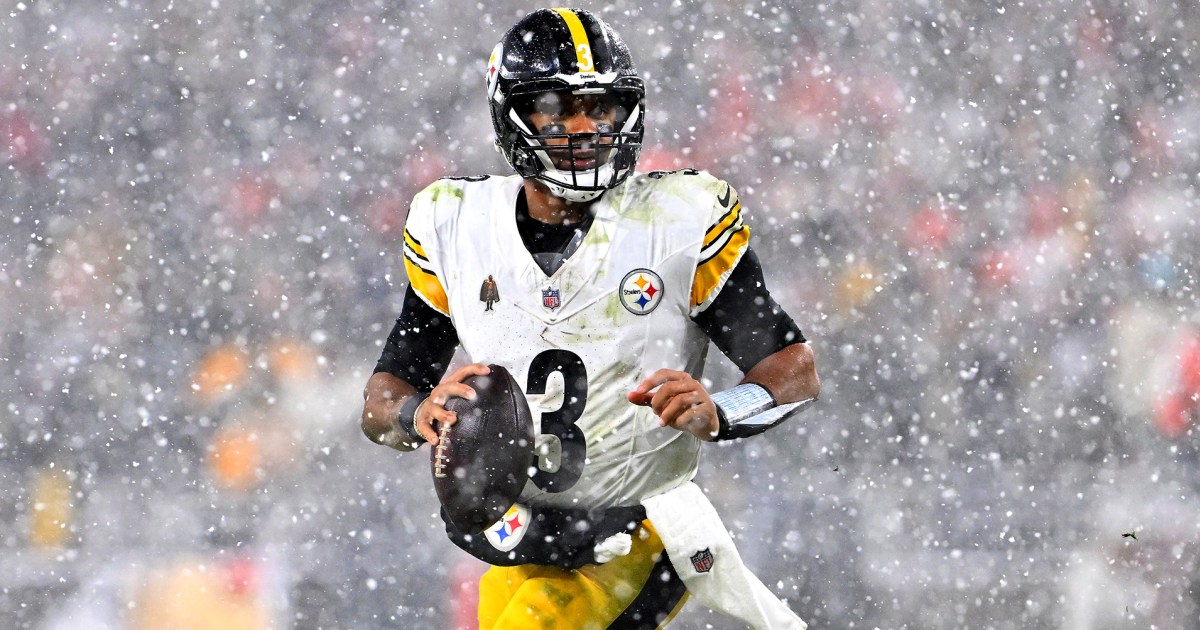When the Pittsburgh Steelers made the midseason decision to switch starting quarterbacks, the move wasn’t exactly celebrated.
Pittsburgh went 4-2 in its first six games with Justin Fields at the helm, leading practically everyone to question why head coach Mike Tomlin would start offseason signee Russell Wilson for the team’s Oct. 20 game against the New York Jets.
“I’ve been trying to figure out what could motivate Tomlin to make this change,” ESPN’s Mina Kimes said a couple of days before the Jets game. “It’s one that I don’t quite understand.”
Kimes’ colleague Ryan Clark, a former Steelers safety, said right after: “I’m with her. I really don’t know what made the decision to go back to Russell Wilson.”
Former Dallas Cowboys defensive end Marcus Spears questioned after Kimes and Clark: “I want to push it forward into thinking what happens if Russ has a bad first or second quarter? Do you go back to Justin Fields immediately?”
All three panelists were more than justified in their confusion.
Wilson missed the start of the season with a calf injury, and he was also coming off his two worst seasons as a professional, having posted an 11-19 record in the previous two years.
In fact, Wilson struggled so much in his two seasons with the Denver Broncos that the team incurred a historic cap penalty to get rid of him. Releasing Wilson cost the Broncos $85 million combined against their salary cap this season and next — the biggest cap penalty ever.
And the move didn’t cost Denver only dead money. The Broncos still had to pay Wilson $39 million this year after they cut him, minus whatever salary he made if he signed with another team. That allowed Pittsburgh to scoop him for a bargain one-year, $1.21 million contract, with Wilson getting $37.79 million more from the Broncos.
So why would the Steelers bench Fields — a former first-round draft pick seemingly realizing his potential — for a quarterback signed off the scrap heap whose last team paid him a fortune to go away?
Because of what Pittsburgh has done in its last six games.
Since he took over in October, Wilson has gone 5-1, taking the Steelers’ offense to new heights while posting some of his best numbers in years.
After having averaged 20.7 points per game with Fields, Pittsburgh is scoring 28.7 with Wilson. And the passing game has been much more dynamic. Fields threw for 184.3 yards per game in his six starts. Wilson, meanwhile, has thrown for 271 yards per game, which is not only a career high but also second-best in the NFL this season.
Though Wilson isn’t the scrambler he was during his heyday with the Seattle Seahawks — a 10-year stint when he led the team to two Super Bowls, winning one, and made nine Pro Bowls — he has helped make up for it by pushing the ball down the field efficiently. He’s averaging a career best in yards per attempt, his highest success rate since 2020 and his lowest sack percentage since 2021.
In Week 13, Wilson threw for 414 yards and led the Steelers to 44 points in a win over the Cincinnati Bengals, the type of shootout it would have been difficult to envision Fields, who threw for under 200 yards in four of his six starts, winning.
There are big tests awaiting Wilson in the final few weeks of the season, however.
While his only loss came against the Cleveland Browns in a snow-filled quagmire on a Thursday night, Wilson will have to show he can take on the league’s best in December.
Pittsburgh will face the 10-2 Philadelphia Eagles and the division rival Baltimore Ravens on the road before they go home to play the AFC-leading Kansas City Chiefs in a three-game stretch from Dec. 15 to Christmas. Each of those games could be a potential playoff preview, and the latter two could have massive implications on postseason seeding.
For now, the Steelers are at 9-3 headed into the final five weeks of the regular season, and Wilson has helped them go up a level. Though it may have been fair to question why Pittsburgh would turn the team over to a veteran seemingly in the downswing of his career, Wilson has proven he was the right man for the job.

